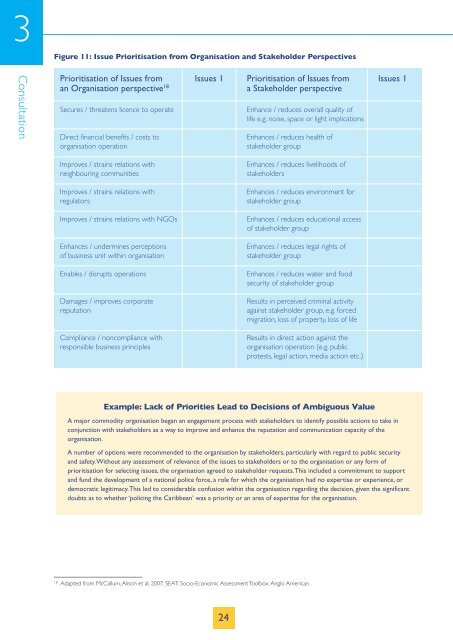Stakeholder Engagement - Cranfield School of Management ...
Stakeholder Engagement - Cranfield School of Management ...
Stakeholder Engagement - Cranfield School of Management ...
You also want an ePaper? Increase the reach of your titles
YUMPU automatically turns print PDFs into web optimized ePapers that Google loves.
3<br />
Consultation<br />
Figure 11: Issue Prioritisation from Organisation and <strong>Stakeholder</strong> Perspectives<br />
Prioritisation <strong>of</strong> Issues from Issues 1 Prioritisation <strong>of</strong> Issues from Issues 1<br />
an Organisation perspective 18 a <strong>Stakeholder</strong> perspective<br />
Secures / threatens licence to operate Enhance / reduces overall quality <strong>of</strong><br />
life e.g. noise, space or light implications<br />
Direct financial benefits / costs to Enhances / reduces health <strong>of</strong><br />
organisation operation stakeholder group<br />
Improves / strains relations with Enhances / reduces livelihoods <strong>of</strong><br />
neighbouring communities stakeholders<br />
Improves / strains relations with Enhances / reduces environment for<br />
regulators stakeholder group<br />
Improves / strains relations with NGOs Enhances / reduces educational access<br />
<strong>of</strong> stakeholder group<br />
Enhances / undermines perceptions Enhances / reduces legal rights <strong>of</strong><br />
<strong>of</strong> business unit within organisation stakeholder group<br />
Enables / disrupts operations Enhances / reduces water and food<br />
security <strong>of</strong> stakeholder group<br />
Damages / improves corporate Results in perceived criminal activity<br />
reputation against stakeholder group, e.g. forced<br />
migration, loss <strong>of</strong> property, loss <strong>of</strong> life<br />
Compliance / noncompliance with Results in direct action against the<br />
responsible business principles organisation operation (e.g. public<br />
protests, legal action, media action etc.)<br />
Example: Lack <strong>of</strong> Priorities Lead to Decisions <strong>of</strong> Ambiguous Value<br />
A major commodity organisation began an engagement process with stakeholders to identify possible actions to take in<br />
conjunction with stakeholders as a way to improve and enhance the reputation and communication capacity <strong>of</strong> the<br />
organisation.<br />
A number <strong>of</strong> options were recommended to the organisation by stakeholders, particularly with regard to public security<br />
and safety.Without any assessment <strong>of</strong> relevance <strong>of</strong> the issues to stakeholders or to the organisation or any form <strong>of</strong><br />
prioritisation for selecting issues, the organisation agreed to stakeholder requests.This included a commitment to support<br />
and fund the development <strong>of</strong> a national police force, a role for which the organisation had no expertise or experience, or<br />
democratic legitimacy.This led to considerable confusion within the organisation regarding the decision, given the significant<br />
doubts as to whether ‘policing the Caribbean’ was a priority or an area <strong>of</strong> expertise for the organisation.<br />
18 Adapted from McCallum, Alison et al. 2007. SEAT: Socio-Economic Assessment Toolbox. Anglo American<br />
24
















